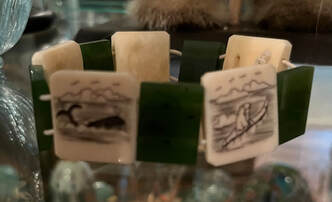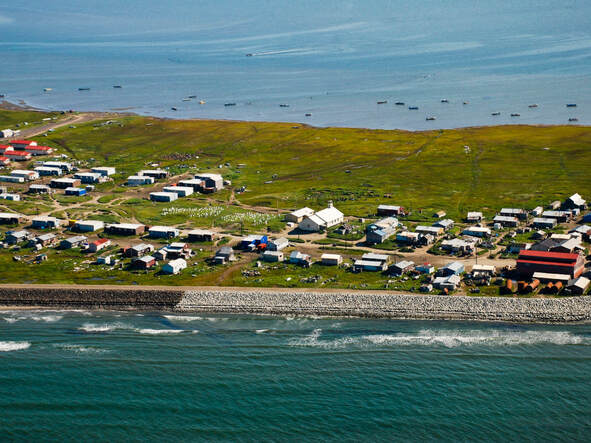Lost in the Smoke
 By Herb Nayukpuk, jade and ivory, needing restringing
By Herb Nayukpuk, jade and ivory, needing restringing
Midway through our adventures in Kotzebue, a distress call came over the radio from a fire near the Candle mining site. A native from Shishmaref, working the fire line, was sick. It was known to his crew members that he had a venereal disease, so the decision was to pick him up and return him to a clinic near his home in Shishmaref.
Since he needed an escort and to be signed off and paid, it was determined that I would fly with him in a small Cessna hired from Galena. The Cessna was flown by a Bush pilot named George. He was able to fly to Kotzebue to pick me up, then proceed to Candle to retrieve the ill firefighter. Although smoke was covering the whole of the Seward Peninsula, the pilot knew the territory and was able to fly us to Shishmaref, about 100 miles over pristine territory that was largely unseen.
There we dispatched our charge and walked into the small town, stopping at the village store. Most of the provisions for the townspeople were sold there. George asked a cashier what the price was for raw ivory from the nearby walrus herd. We had flown low over the coast in order to land and seen a number of headless walrus on the beach. This was a good reason to curtail the harvesting of walrus ivory!
George was told ivory was sold for $20 per pound, but that it was illegal to sell it to non-natives in its raw form. Since I had BLM patches on my shirt and was obviously “government”, the pilot was not going to get his ivory. However, scrimshawed and carved ivory could be sold as native art. We were directed to the studio of Herb Nayukpuk, a well-known elder in Shishmaref. He was famous for running the Iditarod, for his intricate walrus tusk carvings, and being the crew chief for the Shishmaref fire crew. Naturally, he was not in town, being sent to one our distant fires to work.
His daughter was in town, and she gave us a tour of his log cabin studio. In a pair of vices he had a long walrus tusk, intricately carved for a Japanese consignment worth thousands of dollars. In another single vice was a smaller tusk. He had cut it across for a smooth oval shape on the larger end. There he would scratch a scene into the ivory. Then he pressed india ink into the scratches making a scene reflecting one step in a seal hunt. He would later saw it off as a slice, drill and polish it as one piece of a bracelet. I was able to buy two of the finished signed story bracelets- $375 each- that alternated these “slices” with Alaskan jade. One was a gift to my wife and is still in our possession, the other for a BLM colleague.
George and I then walked back down the main street toward his plane. He walked off into the brush to relieve himself, and half of the town’s children followed him like the Pied Piper. He shooed them away and we were able to climb into his Cessna and take off, heading east to return to Kotzebue. This is when the things did not go according to plan.
The pilot was quite familiar with the territory, I thought. We flew east for about 30 minutes. His plan was to fly low into the smoke and intersect with the Buckland River. He could then follow the river north to Kotzebue Sound and make a short hop across the water to the Kotzebue airfield.
We got to a curl of the Buckland River, and he turned right, flying low to follow the river. While we had a good visual look straight down, forward was obscured by white smoke. Still, we followed the river until I noticed a denser plume of dar smoke billowing upward on our left. Since I had mapped every fire in the area, I knew this was a fire to the EAST of the Buckland River. We had not heard from the crew on that fire for several days and thought it was almost put down. But it was cooking! AND it was on our left, meaning we were flying SOUTH, away from Kotzebue and toward Granite Mountain. I told George this and he immediately looked to his instruments. Yes, he was flying south!
Realizing his error, he ascended to 5,00 feet, above the smoke, and radioed to find others also flying high and squawking to each other. He determined that the whole Seward Peninsula was smoked over, so he decided to return to his home base in Galena.
This left me there overnight at a barracks used by other pilots, awaiting a flight back to Kotzebue in an L20 Beaver, departing very early. The smoke on that trip was not terribly obscuring and I was able to sit in the copilot seat so that was a nice trip to home base.
But I decided then that Bush pilots were not all equal and not as deserving of respect just because they flew “in the Bush”.
Oh, did I forget to mention that the fire I had seen “cooking” had indeed chased our fire team around the tundra to seek protection on a sand bar… with a broken radio! Since we could not contact them, we sent out a helicopter to pick them up and they were most grateful that we had thought to bring them home for food and fresh clothing. The fire burned itself out later that week.
Since he needed an escort and to be signed off and paid, it was determined that I would fly with him in a small Cessna hired from Galena. The Cessna was flown by a Bush pilot named George. He was able to fly to Kotzebue to pick me up, then proceed to Candle to retrieve the ill firefighter. Although smoke was covering the whole of the Seward Peninsula, the pilot knew the territory and was able to fly us to Shishmaref, about 100 miles over pristine territory that was largely unseen.
There we dispatched our charge and walked into the small town, stopping at the village store. Most of the provisions for the townspeople were sold there. George asked a cashier what the price was for raw ivory from the nearby walrus herd. We had flown low over the coast in order to land and seen a number of headless walrus on the beach. This was a good reason to curtail the harvesting of walrus ivory!
George was told ivory was sold for $20 per pound, but that it was illegal to sell it to non-natives in its raw form. Since I had BLM patches on my shirt and was obviously “government”, the pilot was not going to get his ivory. However, scrimshawed and carved ivory could be sold as native art. We were directed to the studio of Herb Nayukpuk, a well-known elder in Shishmaref. He was famous for running the Iditarod, for his intricate walrus tusk carvings, and being the crew chief for the Shishmaref fire crew. Naturally, he was not in town, being sent to one our distant fires to work.
His daughter was in town, and she gave us a tour of his log cabin studio. In a pair of vices he had a long walrus tusk, intricately carved for a Japanese consignment worth thousands of dollars. In another single vice was a smaller tusk. He had cut it across for a smooth oval shape on the larger end. There he would scratch a scene into the ivory. Then he pressed india ink into the scratches making a scene reflecting one step in a seal hunt. He would later saw it off as a slice, drill and polish it as one piece of a bracelet. I was able to buy two of the finished signed story bracelets- $375 each- that alternated these “slices” with Alaskan jade. One was a gift to my wife and is still in our possession, the other for a BLM colleague.
George and I then walked back down the main street toward his plane. He walked off into the brush to relieve himself, and half of the town’s children followed him like the Pied Piper. He shooed them away and we were able to climb into his Cessna and take off, heading east to return to Kotzebue. This is when the things did not go according to plan.
The pilot was quite familiar with the territory, I thought. We flew east for about 30 minutes. His plan was to fly low into the smoke and intersect with the Buckland River. He could then follow the river north to Kotzebue Sound and make a short hop across the water to the Kotzebue airfield.
We got to a curl of the Buckland River, and he turned right, flying low to follow the river. While we had a good visual look straight down, forward was obscured by white smoke. Still, we followed the river until I noticed a denser plume of dar smoke billowing upward on our left. Since I had mapped every fire in the area, I knew this was a fire to the EAST of the Buckland River. We had not heard from the crew on that fire for several days and thought it was almost put down. But it was cooking! AND it was on our left, meaning we were flying SOUTH, away from Kotzebue and toward Granite Mountain. I told George this and he immediately looked to his instruments. Yes, he was flying south!
Realizing his error, he ascended to 5,00 feet, above the smoke, and radioed to find others also flying high and squawking to each other. He determined that the whole Seward Peninsula was smoked over, so he decided to return to his home base in Galena.
This left me there overnight at a barracks used by other pilots, awaiting a flight back to Kotzebue in an L20 Beaver, departing very early. The smoke on that trip was not terribly obscuring and I was able to sit in the copilot seat so that was a nice trip to home base.
But I decided then that Bush pilots were not all equal and not as deserving of respect just because they flew “in the Bush”.
Oh, did I forget to mention that the fire I had seen “cooking” had indeed chased our fire team around the tundra to seek protection on a sand bar… with a broken radio! Since we could not contact them, we sent out a helicopter to pick them up and they were most grateful that we had thought to bring them home for food and fresh clothing. The fire burned itself out later that week.
